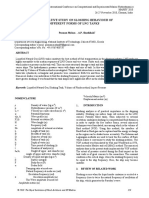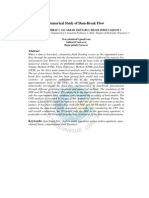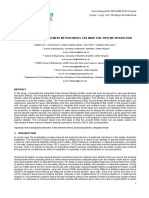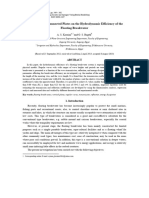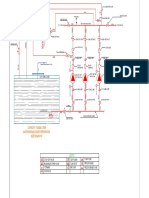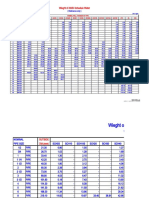PGE 361: 2 (2,1,0) Reservoir Rock Properties and Fluid Flow: Application of ABET Criterion
PGE 361: 2 (2,1,0) Reservoir Rock Properties and Fluid Flow: Application of ABET Criterion
Uploaded by
nomanCopyright:
Available Formats
PGE 361: 2 (2,1,0) Reservoir Rock Properties and Fluid Flow: Application of ABET Criterion
PGE 361: 2 (2,1,0) Reservoir Rock Properties and Fluid Flow: Application of ABET Criterion
Uploaded by
nomanOriginal Description:
Original Title
Copyright
Available Formats
Share this document
Did you find this document useful?
Is this content inappropriate?
Copyright:
Available Formats
PGE 361: 2 (2,1,0) Reservoir Rock Properties and Fluid Flow: Application of ABET Criterion
PGE 361: 2 (2,1,0) Reservoir Rock Properties and Fluid Flow: Application of ABET Criterion
Uploaded by
nomanCopyright:
Available Formats
Application of ABET Criterion
King Saud University
Petroleum Engineering Department
PGE 361: 2(2,1,0)
Reservoir Rock Properties and Fluid Flow
Instructor:
Assistant Professor. Ahmed A. Gawish, Petroleum Engineering
Office: 2B-86.
Phone: 966 1 4676889
E-mail: agawish@ksu.edu.sa
Textbooks:
1. Applied Reservoir Engineering. Chapter (2) (Properties of Reservoir Rocks)
By Charles R. Smith, et. al.
2. Petroleum Reservoir Engineering (Physical Properties) Chapters (2, and 3),
James W. Amyx, et. al. 1960.
3. Reservoir Engineering Handbook, Second Edition, Gulf Professional
Publishing, Chapters (4, and 5), Tarek Ahmed 2001.
4. Petroleum Engineering Handbook Chapter (26), Howard B. Bradley, et. al.
Third printing SPE. 1992.
5. Principles of Petroleum Reservoir Engineering Chapter (3) By Gian Luigi
Chierici, Translated from the Italian by Peter J. Westaway, 1995.
6. Worldwide Practical Petroleum Reservoir Engineering Methods, H.C. "Slip"
Slider, 1983.
7. Fundamentals of Reservoir Engineering. Amsterdam: Elsevier Scientific
Publishing Company, Dake, 1978.
Prerequisite:
PE 251
Description
Porosity and its types, permeability and its types, capillary pressure curves,
laboratory determination of physical properties (core analysis), subsurface
measurement, steady state and unsteady state flow of incompressible and
compressible fluids in linear and radial porous system.
Objectives:
To instruct the students in the fundamentals of reservoir rock properties and
flow of fluids through porous media.
Topics Covered:
1. Rock Porosity: definition of porosity, total porosity, absolute porosity,
primary and secondary porosity, factors affecting porosity, measurement of
porosity, and subsurface measurement of porosity (3 classes)
2. Permeability: definition of permeability, absolute permeability, effective
permeability. General form of Darcy's law, single phase flow of
incompressible, slightly compressible and compressible fluid in linear and
radial porous media. Horizontal and vertical flow, Klinkenberg effect.
3.
4.
5.
6.
7.
8.
Average absolute permeability, weighted, harmonic, and geometric average
permeability. Flow in channels and fractures. Measurment of permeability.
Absolute permeability correlations, Timur, Morris-Biggs equations. (10
classes)
Fluid Saturations: definition and the significance of the critical saturation for
each phase, methods for determining fluid saturations, factors affecting fluid
saturation. ( 2 classes)
Wettability definition and calculation, surface and interfacial tension, capillary
pressure, laboratory measurements of capillary pressure, capillary pressure
curves and hysteresis, initial saturation distribution in a reservoir, Leverett JFunction, and converting laboratory capillary data. (5 classes)
Single phase flow in porous rock and multiphase flow in porous rock: Darcy's
equation and reservoir systems, relative permeability, drainage and imbibition
process. Effective and relative permeability, laboratory determination of
relative permeability, two-phase relative permeability correlations, relative
permeability from capillary pressure data, relative permeability from
analytical equations, relative permeability ratio, dynamic pseudo-relative
permeabilitys, normalization and averaging relative permeability data. Threephase relative permeability use of effective and relative permeability. (7
classes)
Electrical properties of rock-fluid systems: electrical conductivity of fluid
saturated rock, use of electrical formation resistivity factor, cementation
factor, and saturation exponent resistivity relations, measurement of electrical
properties of rock, effect of clay on resistivity. empirical correlation of
electrical properties. (3 classes)
Classes problems (16 classes)
Tests: (2 classes plus final exam.)
Classes/Tutorials: Class are held two times per week in 50 minutes lectures plus one tutorial
class of 50 minutes per week
Evaluation
10% for Attendance, participation, quizzes and home works. 40% for two
midterm exams and 50% for the final examination.
Course Improvement Actions:
Some basic background and prerequisite material are often reviewed during this course.
Course contents are regularly reviewed and up to date materials are quoted.
You might also like
- Grade Mixing Analysis in Steelmaking Tundishusing Different Turbulence ModelsDocument6 pagesGrade Mixing Analysis in Steelmaking Tundishusing Different Turbulence ModelsrakukulappullyNo ratings yet
- The Influences of A Liquid Storage Tanks and Soil Characteristics Under Seismic LoadsDocument8 pagesThe Influences of A Liquid Storage Tanks and Soil Characteristics Under Seismic LoadsAnonymous f5gNPeZDCNo ratings yet
- Reservoir Rock Properties and Fluid FlowDocument2 pagesReservoir Rock Properties and Fluid Flowtassili17No ratings yet
- Me (Wre&gis)Document15 pagesMe (Wre&gis)Mohamed Nageeb SalemNo ratings yet
- Fluid Flow Modeling in FracturesDocument41 pagesFluid Flow Modeling in FracturesAlberto RomanNo ratings yet
- Study On Sloshing Frequencies of Fluid-Tank SystemDocument8 pagesStudy On Sloshing Frequencies of Fluid-Tank Systempn1313No ratings yet
- CFD Letters2Document20 pagesCFD Letters2Eswaran MuthaiahNo ratings yet
- Accepted Manuscript: Computers and Chemical EngineeringDocument25 pagesAccepted Manuscript: Computers and Chemical EngineeringAndres RodriguezNo ratings yet
- River Water Quality Modelling: State of The ArtDocument8 pagesRiver Water Quality Modelling: State of The ArtWilliam JaimesNo ratings yet
- Application of Muskingum Routing Method With Variable Parameters in Ungauged BasinDocument12 pagesApplication of Muskingum Routing Method With Variable Parameters in Ungauged Basinsherif ashrafNo ratings yet
- 2002 Int Ansys Conf 168Document16 pages2002 Int Ansys Conf 168Eduardo Leal SalgadoNo ratings yet
- Optimization of Flotation Circuits by Modelling AnDocument12 pagesOptimization of Flotation Circuits by Modelling AnDiego Alonso Diaz CayllahuaNo ratings yet
- An Investigation Into The Liquid Sloshing Characteristics of Ground Anchored Tanks During Lateral VibrationDocument18 pagesAn Investigation Into The Liquid Sloshing Characteristics of Ground Anchored Tanks During Lateral Vibrationtarekelhalabi1994No ratings yet
- Computaion of Gravity Current in EstuaryDocument105 pagesComputaion of Gravity Current in EstuaryVU Huy CongNo ratings yet
- ch2 Literature-1Document13 pagesch2 Literature-1azeempathan0No ratings yet
- 1983-Vibration Studies and Tests of Liquid Storage TanksDocument28 pages1983-Vibration Studies and Tests of Liquid Storage TanksbehzadNo ratings yet
- Yang Man RevisedDocument10 pagesYang Man ReviseddequanzhouNo ratings yet
- MARHY18 S26 Poonam Mohan PDFDocument8 pagesMARHY18 S26 Poonam Mohan PDFPoonam MohanNo ratings yet
- The Influence of Knudsen Number On The Hydrodynamic Development Length Within Parallel Plate Micro-ChannelsDocument10 pagesThe Influence of Knudsen Number On The Hydrodynamic Development Length Within Parallel Plate Micro-ChannelsChong Jen HawNo ratings yet
- M.tech (Water Resourses Engg) SyllabusDocument22 pagesM.tech (Water Resourses Engg) SyllabusHariom KhungarNo ratings yet
- Journal of Mechanical Engineering - Strojnícky Časopis: VOLUME 66, NO 2, 2016Document10 pagesJournal of Mechanical Engineering - Strojnícky Časopis: VOLUME 66, NO 2, 2016Julio Andrés Casal RamosNo ratings yet
- Fluid Structure Interaction EffectsDocument51 pagesFluid Structure Interaction EffectsvttrlcNo ratings yet
- 30978Document10 pages30978reza_putra_11No ratings yet
- Method For Quick Prediction of Hydraulic Conductivity and Soil-Water Retention of Unsaturated SoilsDocument10 pagesMethod For Quick Prediction of Hydraulic Conductivity and Soil-Water Retention of Unsaturated SoilsShaoyang DongNo ratings yet
- Miquel Bouaanani Engineering Structures 2010Document35 pagesMiquel Bouaanani Engineering Structures 2010rlprNo ratings yet
- Shoshing Effect in TanksDocument7 pagesShoshing Effect in Tankssaurabh singhNo ratings yet
- Computation of Flow and Resistance Around LNG Carrier in Deep and Shallow WaterDocument6 pagesComputation of Flow and Resistance Around LNG Carrier in Deep and Shallow WaterGoutam Kumar SahaNo ratings yet
- Zhang2016 Geomecanica CCS CarbonatosDocument10 pagesZhang2016 Geomecanica CCS Carbonatosjolugoto1991No ratings yet
- 1 s2.0 S167477552300032X MainDocument16 pages1 s2.0 S167477552300032X MainSimmonviegasNo ratings yet
- Reservoir Rock and Fluid PropertiesDocument2 pagesReservoir Rock and Fluid PropertiesRahul MaratheNo ratings yet
- 1-s2.0-0920410592900372-mainDocument2 pages1-s2.0-0920410592900372-mainCrysart SlayedNo ratings yet
- Chemistry Journal Chjv06i02p0127Document16 pagesChemistry Journal Chjv06i02p0127Meysam BayazidiNo ratings yet
- Hydrodynamic Forces On Subsea Pipelines - KarremanDocument6 pagesHydrodynamic Forces On Subsea Pipelines - KarremanAlberto darianNo ratings yet
- Behaviour of Elevated Water Tank Considering Sloshing EffectDocument32 pagesBehaviour of Elevated Water Tank Considering Sloshing Effectazeempathan0No ratings yet
- Study On The Optimal Wave Energy Absorption Power of A Float in WavesDocument14 pagesStudy On The Optimal Wave Energy Absorption Power of A Float in WavesAdorkable LuanNo ratings yet
- CONCEPTS - A Process-Based Modeling Tool To Evaluate Stream-Corridor Restoration DesignsDocument11 pagesCONCEPTS - A Process-Based Modeling Tool To Evaluate Stream-Corridor Restoration DesignsdequanzhouNo ratings yet
- Articulo Jaime Gonzalez PDFDocument6 pagesArticulo Jaime Gonzalez PDFFélix Gallo CruzNo ratings yet
- Numerical Study of Dam-Break Flow - Omid SeyedashrafDocument9 pagesNumerical Study of Dam-Break Flow - Omid SeyedashrafseyedashrafNo ratings yet
- Flow Over A Broad-Crested Weir in Subcritical Flow Conditions, Physical StudyDocument6 pagesFlow Over A Broad-Crested Weir in Subcritical Flow Conditions, Physical Studyho_afsharNo ratings yet
- Syllabus - Pete 592 - KfupmDocument3 pagesSyllabus - Pete 592 - KfupmAlPrince007No ratings yet
- Analytical and Numerical Modeling of Flow in A Fractured Gneiss AquiferDocument6 pagesAnalytical and Numerical Modeling of Flow in A Fractured Gneiss Aquifermoody_ceNo ratings yet
- Wave-Soil-Structure Interaction (WSSI) .Document9 pagesWave-Soil-Structure Interaction (WSSI) .Romoex R RockNo ratings yet
- Effect of Flow Velocity and Particle Size On Erosion in A Pipe With Sudden ContractionDocument17 pagesEffect of Flow Velocity and Particle Size On Erosion in A Pipe With Sudden ContractionHao XuNo ratings yet
- ATCE SPE 210293 MS - 100422 - HoustonDocument23 pagesATCE SPE 210293 MS - 100422 - HoustonSarang BhideNo ratings yet
- Yaqub 2018 IOP Conf. Ser. Mater. Sci. Eng. 458 012078Document10 pagesYaqub 2018 IOP Conf. Ser. Mater. Sci. Eng. 458 012078Daniel MoraesNo ratings yet
- In Line Vs Cross Flow PDFDocument8 pagesIn Line Vs Cross Flow PDFakhmadmarufnurNo ratings yet
- P - Effect of Under Connected Plates On The Hydrodynamic Efficiency of The Floating Breakwater (2013)Document14 pagesP - Effect of Under Connected Plates On The Hydrodynamic Efficiency of The Floating Breakwater (2013)Ahmed BalahNo ratings yet
- Chemistry Honours RegularDocument72 pagesChemistry Honours RegularSk ArmaanNo ratings yet
- Review of Pipeline Span Analyis-2019Document78 pagesReview of Pipeline Span Analyis-2019Anjani PrabhakarNo ratings yet
- Fractured ReservoirsDocument23 pagesFractured Reservoirstassili17No ratings yet
- Ch4 MethodologyDocument6 pagesCh4 Methodologyazeempathan0No ratings yet
- Detection of The Gas-Liquid Two-Phase Flow Regimes Using Non-Intrusive Microwave Cylindrical Cavity SensorDocument14 pagesDetection of The Gas-Liquid Two-Phase Flow Regimes Using Non-Intrusive Microwave Cylindrical Cavity SensorgopalNo ratings yet
- River EngineeringDocument56 pagesRiver EngineeringChinmoy TalukdarNo ratings yet
- Francis Runner Analysis Using FEM PDFDocument6 pagesFrancis Runner Analysis Using FEM PDFAnonymous AkzeMHNTUyNo ratings yet
- CFD Ball ValveDocument8 pagesCFD Ball ValveKelvin Octavianus DjohanNo ratings yet
- Prediction of Flow Velocity Near Inclined Surfaces With Varying RoughnessDocument9 pagesPrediction of Flow Velocity Near Inclined Surfaces With Varying RoughnessChristian PablicoNo ratings yet
- Finite Element Analysis of Steel Storage Tank Under Siesmic PDFDocument8 pagesFinite Element Analysis of Steel Storage Tank Under Siesmic PDFBala SutharshanNo ratings yet
- E060701020025 PDFDocument6 pagesE060701020025 PDFمنير أحمدNo ratings yet
- Fundamentals of the Petrophysics of Oil and Gas ReservoirsFrom EverandFundamentals of the Petrophysics of Oil and Gas ReservoirsNo ratings yet
- Ezium Development Plan: S.No RM Name Region Mie Name Identified BricksDocument3 pagesEzium Development Plan: S.No RM Name Region Mie Name Identified BricksnomanNo ratings yet
- New Doc 2018-06-02Document1 pageNew Doc 2018-06-02nomanNo ratings yet
- Training On SwellmeterDocument1 pageTraining On SwellmeternomanNo ratings yet
- Ezium Development Plan: S.No RM Name Region Mie Name Identified BricksDocument3 pagesEzium Development Plan: S.No RM Name Region Mie Name Identified BricksnomanNo ratings yet
- Ezium Development Plan-Waqas RanaDocument3 pagesEzium Development Plan-Waqas RananomanNo ratings yet
- Australia Awards Scholarships Pakistan Intake 2018 Eligibility ChecklistDocument2 pagesAustralia Awards Scholarships Pakistan Intake 2018 Eligibility ChecklistnomanNo ratings yet
- New Arrival of Equipment in Petroleum Engineering DepartmentDocument1 pageNew Arrival of Equipment in Petroleum Engineering DepartmentnomanNo ratings yet
- Annex A: Handset Purchase Form For SamsungDocument1 pageAnnex A: Handset Purchase Form For SamsungnomanNo ratings yet
- Assignment # 01Document1 pageAssignment # 01nomanNo ratings yet
- Tank Pressure Vs TimeDocument1 pageTank Pressure Vs TimenomanNo ratings yet
- Electric Fracturing: 4.2.1 Pulsed Arc Electrohydraulic Discharges (PAED)Document2 pagesElectric Fracturing: 4.2.1 Pulsed Arc Electrohydraulic Discharges (PAED)nomanNo ratings yet
- Government Employer Registration Information Form: Prime Minister Youth Training SchemeDocument3 pagesGovernment Employer Registration Information Form: Prime Minister Youth Training SchemenomanNo ratings yet
- 2 - Quran and Math - ADocument21 pages2 - Quran and Math - Atifl100% (1)
- Standard Membrane Bioreactor ComputationsDocument8 pagesStandard Membrane Bioreactor ComputationsSwaminathan ThayumanavanNo ratings yet
- Concentric Tube Water-Water Heat Exchanger Study UnitDocument12 pagesConcentric Tube Water-Water Heat Exchanger Study Unitseraj ibramemNo ratings yet
- Boom System (M0081158-08)Document5 pagesBoom System (M0081158-08)Guido Emanuel SteinbachNo ratings yet
- Partslist - A025 - Backhoe 205Document7 pagesPartslist - A025 - Backhoe 205Павел ХромовNo ratings yet
- 01 Introduction To Well CompletionsDocument49 pages01 Introduction To Well CompletionsMuhammad Abubakar100% (1)
- PB100 DatasheetDocument2 pagesPB100 Datasheetvimal viswanathNo ratings yet
- Typical Pump Room DesignDocument1 pageTypical Pump Room DesignAhsan Habib TanimNo ratings yet
- FABIG TM83 5 JPappasDocument11 pagesFABIG TM83 5 JPappasGion67No ratings yet
- Tutorial-Chapter 2 (June - Oct 2013)Document5 pagesTutorial-Chapter 2 (June - Oct 2013)paulineanakmawatNo ratings yet
- Wieght of ANSI Schedule Water: (Reference Only)Document12 pagesWieght of ANSI Schedule Water: (Reference Only)கோகுல் இராNo ratings yet
- Fuel Oil SystemDocument35 pagesFuel Oil SystemChris Belga100% (2)
- Banana Cold Storage: Chapter 2: Related LiteratureDocument8 pagesBanana Cold Storage: Chapter 2: Related LiteratureVelaNo ratings yet
- Lecture 5: Diffusion Coefficient (Diffusivity) : LN LNDocument6 pagesLecture 5: Diffusion Coefficient (Diffusivity) : LN LNKrishnadev Madhavan NairNo ratings yet
- Module 1: Introduction and Thermochemistry: Objectives, Scope, Required Reading, & Assignment ScheduleDocument18 pagesModule 1: Introduction and Thermochemistry: Objectives, Scope, Required Reading, & Assignment ScheduleAna Emily PrentissNo ratings yet
- 32 Samss 007Document84 pages32 Samss 007Inamullah Khan100% (1)
- SprayBall Design - Pressure Drop - Ken Morrison ArticleDocument6 pagesSprayBall Design - Pressure Drop - Ken Morrison ArticleHejoolju GrubsNo ratings yet
- Chapter 4 Chemical KineticsDocument106 pagesChapter 4 Chemical Kineticsabu40666No ratings yet
- Flowhead PsDocument2 pagesFlowhead PsDani Juanda100% (1)
- Carbon Molecular Sieve DataDocument6 pagesCarbon Molecular Sieve DataShashank RaiNo ratings yet
- Production Engineer Interview Questions Part 2Document5 pagesProduction Engineer Interview Questions Part 2Rizwan FaridNo ratings yet
- 7.3 Non-Flowing FluidsDocument9 pages7.3 Non-Flowing FluidsdongdanhbeNo ratings yet
- Hyaluronic-Acid PresentationDocument9 pagesHyaluronic-Acid PresentationGeorge LapusneanuNo ratings yet
- Pumpsil Tubing: Ideal ForDocument2 pagesPumpsil Tubing: Ideal Forpedro fiolhaisNo ratings yet
- Microbelift Technology For Anaerobic DigestorDocument15 pagesMicrobelift Technology For Anaerobic Digestordannlee74No ratings yet
- سنوات قديمةDocument79 pagesسنوات قديمةahmed alseileanNo ratings yet
- CMPC Protisa PP3 Process Description Rev1Document39 pagesCMPC Protisa PP3 Process Description Rev1tecsup116No ratings yet
- Gas Vapor MixturesDocument47 pagesGas Vapor MixturesMo SalihNo ratings yet
- Heat Exchanger Input Correction FactorDocument11 pagesHeat Exchanger Input Correction FactorTrần Tuấn VũNo ratings yet
- Astm A213 PDFDocument2 pagesAstm A213 PDFLam Duy TienNo ratings yet
- Fluid Mechanics Main File Paf 18-9-2020Document182 pagesFluid Mechanics Main File Paf 18-9-2020Gangesh SinghNo ratings yet

















